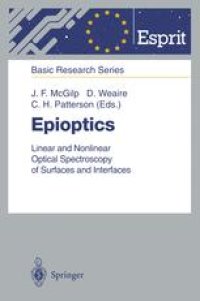
Ebook: Epioptics: Linear and Nonlinear Optical Spectroscopy of Surfaces and Interfaces
- Tags: Image Processing and Computer Vision, Solid State Physics, Spectroscopy and Microscopy, Optics Optoelectronics Plasmonics and Optical Devices
- Series: Esprit Basic Research Series
- Year: 1995
- Publisher: Springer-Verlag Berlin Heidelberg
- Edition: 1
- Language: English
- pdf
The study of condensed matter using optical techniques, where photons act as both probe and signal, has a long history. It is only recently, however, that the extraction of surface and interface information, with submonolayer resolution, has been shown to be possible using optical techniques (where "optical" applies to electromagnetic radiation in and around the visible region of the spectrum). This book describes these "epioptic" techniques, which have now been quite widely applied to semiconductor surfaces and interfaces. Particular emphasis in the book is placed on recent studies of submonolayer growth on well-characterised semiconductor surfaces, many of which have arisen from CEC DGJGII ESPRIT Basic Research Action No. 3177 "EPIOPTIC", and CEU DGIII ESPRIT Basic Research Action No. 6878 "EASI". Techniques using other areas of the spectrum such as the infra-red region (IR spectroscopy, in its various surface configurations), and the x-ray region (surface x-ray diffraction, x-ray standing wave), are omitted. The optical techniques described use simple lamp or small laser sources and are thus, in principle, easily accessible. Epioptic probes can provide new information on solid-gas, solid-liquid and liquid-liquid interfaces. They are particularly suited to growth monitoring. Emerging process technologies for fabricating submicron and nanoscale semiconductor devices and novel multilayer materials, whether based on silicon or compound semiconductors, all require extremely precise control of growth at surfaces. In situ, non-destructive, real-time monitoring and characterisation of surfaces under growth conditions is needed for further progress. Both atomic scale resolution, and non-destructive characterisation of buried structures, are required.
This book describes recent developments in optical techniques for extracting surface and interface information with a resolution of less than a single atomic layer. These new "epioptic" techniques have now been quite widely applied to semiconductor surfaces and interfaces, and include polarised reflection techniques such as reflection anisotropy spectroscopy and spectroscopic ellipsometry, Raman scattering, and optical second harmonic and sum frequency generation. Epioptics has great potential in the area of growth monitoring, and in situ monitoring of semiconductor growth with submonolayer sensitivity has now been demonstrated in growth reactors under normal operating conditions. The book emphasizes recent studies of submonolayer growth on semiconductor surfaces.
This book describes recent developments in optical techniques for extracting surface and interface information with a resolution of less than a single atomic layer. These new "epioptic" techniques have now been quite widely applied to semiconductor surfaces and interfaces, and include polarised reflection techniques such as reflection anisotropy spectroscopy and spectroscopic ellipsometry, Raman scattering, and optical second harmonic and sum frequency generation. Epioptics has great potential in the area of growth monitoring, and in situ monitoring of semiconductor growth with submonolayer sensitivity has now been demonstrated in growth reactors under normal operating conditions. The book emphasizes recent studies of submonolayer growth on semiconductor surfaces.
Content:
Front Matter....Pages I-XII
Introduction....Pages 1-13
The Linear Optical Response....Pages 15-38
Spectroscopic Ellipsometry....Pages 39-76
Reflection Difference Techniques....Pages 77-102
Raman Spectroscopy....Pages 103-131
Photoluminescence Spectroscopy....Pages 133-162
On the Theory of Second Harmonic Generation....Pages 163-181
Second Harmonic and Sum Frequency Generation....Pages 183-206
Conclusions....Pages 207-209
Back Matter....Pages 211-232
This book describes recent developments in optical techniques for extracting surface and interface information with a resolution of less than a single atomic layer. These new "epioptic" techniques have now been quite widely applied to semiconductor surfaces and interfaces, and include polarised reflection techniques such as reflection anisotropy spectroscopy and spectroscopic ellipsometry, Raman scattering, and optical second harmonic and sum frequency generation. Epioptics has great potential in the area of growth monitoring, and in situ monitoring of semiconductor growth with submonolayer sensitivity has now been demonstrated in growth reactors under normal operating conditions. The book emphasizes recent studies of submonolayer growth on semiconductor surfaces.
Content:
Front Matter....Pages I-XII
Introduction....Pages 1-13
The Linear Optical Response....Pages 15-38
Spectroscopic Ellipsometry....Pages 39-76
Reflection Difference Techniques....Pages 77-102
Raman Spectroscopy....Pages 103-131
Photoluminescence Spectroscopy....Pages 133-162
On the Theory of Second Harmonic Generation....Pages 163-181
Second Harmonic and Sum Frequency Generation....Pages 183-206
Conclusions....Pages 207-209
Back Matter....Pages 211-232
....